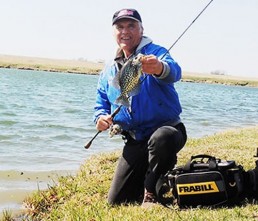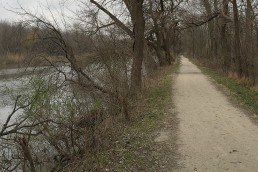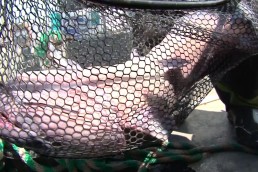Fish ‘N’ Tales®
SHARE THIS POST
Fishing in Strong Crosswinds
Fishing a strong crosswind can be extremely tough. It can also be extremely productive, if the right place is found and the correct presentation is used.
First off, I will categorize and define a strong crosswind. The types of strong crosswinds can vary depending on the lake and area into which the wind is being funneled. Generally, it would be anything placing a mild to heavy (white cap) chop on the water. The heavier the waves, the tougher it is to make a successful presentation.
Some of the best locations are those with weed bed islands, rock and brush piles, and stumps that are off shore, so that the wind goes over and around both sides of the area. This allows for different areas that may hold fish—front, top, sides and back, and sometimes middle. In most cases, once you find where fish are holding, it will carry over to similar areas.
For example, the wind is creating a current and many times the fish are on the back side (downwind) to capture food being washed over and around both sides. Weed islands provide the most possibility, because fish may be inside as well as on the outside and back. Second would be brush piles, which would be similar to the weed islands, but with less fish in the middle; third, stumps which may have fish that are holding in washed out root systems, that can extend much further out from the stump; and fourth, a rock pile that can have fish about anywhere, but not inside unless there is a hole or some sort of extra outcrop.
Points are also another good location that is made even better if they have some of the aforementioned structures. Normally, I like fishing the point with the lure coming to the downwind side, but that is not always possible if fishing from shore.
The toughest part is making a cast that falls where it is needed, and then retrieving it without the wind and waves pulling it the wrong direction or out of the water. While either casting or spinning can be used, spinning is often less trouble. You might encounter possible backlashes with a casting reel when adjusting to make longer casts, which are needed for this type of fishing.
Are you enjoying this post?
You can be among the first to get the latest info on where to go, what to use and how to use it!
A cast is made slightly upwind and past the targeted area. At the same time, the slack is wound up quickly to start the retrieve. With a spinning outfit, the reel’s pail can be engaged quickly before the lure hits the water. The rod tip is kept close to the surface, and in many cases, placed a few inches beneath the surface in extremely heavy white cap conditions. The line is kept straighter and not carried by the wind or wave action. Keeping the line straighter makes the difference in catching fish. Too much bow in the line not only pulls the lure in the wrong direction, but also loses the feel of the strike.
Lure selection is best with something fast. Start with a Rat-L-Trap, and make sure you have a rig with one ready all day. This is one of the best. Next will be lures that can be moved a little slower, but still provide some quickness. These are spinnerbaits; Road Runners; Blitz Spyder Finesse Jigs with a curl tail (single or twin) trailer; and 2-inch Power Minnow, 2-inch and 3.5-inch Ripple Shad and 3-inch Twitch Tail Minnows on H20 jig heads.
Spinnerbaits and Road Runners are fished with the normal steady retrieve, with the possible addition of a “finger jigging” to the Road Runner. The Spyder Jig is brought along with a quick swimming action rather than fishing as a bottom bumping bait. As for the minnow and swimbait-style baits on the H20 heads, I will use them with a “finger jigging” technique 99 percent of the time, with a varied speed, depending on how straight the line can be maintained.
The strike is often difficult to detect. In most cases, it feels like a “hang up,” but with the difference that it pulls back or runs to the side. With weeds, it is the most difficult, because it only takes a small piece of weed to make it feel like a fish is on. However, go ahead and set the hook, as you never know when it could be the “big one.”
All of these techniques can be used from shore or boat, but they are the most useful to shore line anglers. With a boat it would be best to point the bow into the wind—especially with a bow-controlled trolling motor—to stabilize and hold the rig in position. Anchoring is possible, but controlling it without anchors is best to maneuver into different positions. In addition, using a boat makes it possible to fish the area with the lure coming down wind. You can then avoid making crosswind casts. With shore, you can walk up and down to take casts at the different areas of a structure.
A strong crosswind can be a pain, but if fished correctly, it can be the cure for a fishless headache.
MWO
SHARE THIS POST
Did you enjoy this post?
You can be among the first to get the latest info on where to go, what to use and how to use it!
Dan Galusha
Dan Galusha has fished all of his life, worked more than 45 years in the outdoor/media industry, and was inducted into the Fresh Water Fishing Hall of Fame as a Legendary Communicator. Direct questions through dansfishntales.com, facebook.com/dansfishntales and facebook.com/shootnplink.



